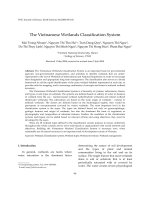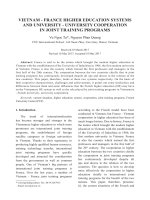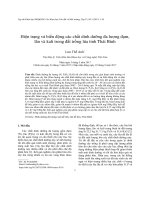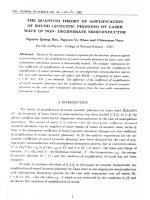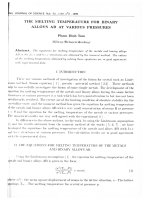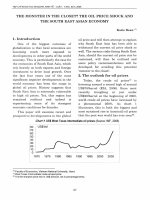DSpace at VNU: The Vietnamese Wetlands Classification System
Bạn đang xem bản rút gọn của tài liệu. Xem và tải ngay bản đầy đủ của tài liệu tại đây (1.01 MB, 8 trang )
VNU Journal of Science, E arth Sciences 24 (2008) 96-103
The Vietnamese VVetlands Classiíication System
Mai Trong N huan1, Nguyên Thi Thu Ha2'*, Tran Dang Quy2, Nguycn Thi Ngoe2,
Do Thi Thuy Linh2, Nguyen Thi Minh Ngoe2, Nguyen Thi Hong Hue2, Pham Bao Ngoe2
1 Vietnam National Univcrsity, Hattoi
2College of Science, VNU
Rcceivcd 1 M ay 2008; reccivcd in revised form 3 July 2008
A bstract. T he V ietnam ese VVotlands C lassiíication System is an im p o rta n t basis for g o v ern m e n tal
agcncies, n o n -g o v ern m cn tal o rg a n i/a tio n s, and scientists to id en tiíy w e tla n d s th at are u n đ e rrep resen ted in the List of VVetlands of International an d N ational Im p o rtan c e in o rd e r to e n c o u ra g e
th eir d esig n atio n a n d ap p ro p riato long tcrm m anagem ent. T he cỉassiíication also scrves as a b ro a d
fram ew o rk to aid th e ra p id identiíication of tho m ain vvetlanđ h ab itats represontod nt each si te, to
provide u n its for m ap p in g , and to cn co u rag e uniíorm ity of concepts an d torm s in national vvetland
inventory.
T he V ietnam csc VVetỉands C lassiíication System is a h ierarchy of system s, su b sy stem s, cỉassos,
an d typos o r su b -ty p cs of vvotlancỉs. Tho system s arc d o íỉn ed based on snlinity of vvater or d istan ce
of w etlan d írom th e sca - m arine/coastal vvetland (salty/brackish w otlnnds) a n d ỉnland vvetland
(fresh w ater w etỉands). T he subsystem s are based on tho m ain o rig in (>f v v ctb n d s - n a tu ra l or
artiíicial w etlan d s. The classes are d eíin ed based on th e hydrological rogim e, thL'y w o u ld bo
p erm an o n t or n o n -p e rm an en t (covered by w ater) w etlan d s. Tho m ost im p o rta n t levcl in the
classiíication system is th e types. The types are d c íin e d based not o nly on goom orpholo g ic,
gcologic íeatu res an d origin of vvetlands, but also th e d o m in a n t liíe form of v eg c ta tỉo n or
p h y sio g rap h y and com position of su b strate íeatures. F urther, the m o d iíie rs o f th e d assiíic a tio n
system s (su b-types) can be a d d c d bascd on relevant criteria and u sỉn g obịectivcs; th cy m u st be
d ev elo p ed by tho uscrs.
T here are 38 vvotlnnd typcs d cíin cd in tho classiíication sy stem p u rp o s e to c n s u re u n iío rm ity
th ro u g h o u t the w h o lc co u n try a n d to servc in d iv id u als o r o rg a n i/a ỉio n s w ith variod in terc sts a n d
obịectives. B uilding th e V ietnăm ese W otland C lassiíication System is necossary novv, whc?n
sustain ab lo u s e o f n atu ra l rcsourccs is an im p o rtan t task o f d e v e lo p m c n t co u rse of V ietnam .
Keyivords: VVctland; Ciassiíication system; VVetlanđ types; W ctland inventory; VVctlanđ m anagem cnt.
determ ining the nature of soil developm ent
and the types of plant and anim al
com m unities living in the soil and on its
suríace. The single íeaturc that m ost wetlancỉs
share is soil or substrate that is at least
periodicallỵ saturated w ith or covered by
w ater. The vvater crcates severe physiological
1. Introduction
In general, w etlands are lands where
w ater saturation is the dom inant íactor
* Corresponding aưthor. Tcl.: 84-4-5587060.
E-mail: hantt_kdcCõ>vnu.edu.vn
96
M ni Trong Nhunrt ct nì. Ị VNU Ịournaỉ of Science, Earth Sciences 24 (2008) 96-103
97
problcm s for all plants and animal exccpt
those th at are a d ap ted for life in w ater or in
satu rated soil [ I Ị.
A ccording to the RAMSAR Convention,
vvetlands are areas of m arsh, fen, peat land or
vvater, w hether natural or artiíicial, perm anent
or tem porary, vvith w ater that is static or
ílovving, íresh, brackish or salt, inciuding
areas of m arine w ater the d epth of which at
low tide does n o t exceed six m eters [3Ị.
YVetland d ev elo p m en t is a íunction of
clim ate (precipitation, tem perature, vvind and
insolation), h ydrology (internal and external
drainage), chem istry (w ater and soils),
geom orphology (landíorm and soil parent
m aterial), and biology (fauna and ílora).
VVetland d ev elo pm en t is dynam ic since
various
types
of
w etlands
represent
transitions from one type to another. As a
result, w ctlands o íten share characteristics of
m ore than one vvetland class or type.
V ietnam has a shoreline of 3,260 km in
length, about 3,000 near-shore islands and
m ore than 100 estuaries. The Vietnamese
Coastal zone is characterized by various
vvetlands which arc divcrsc not only in types,
íunctions, ecosystem s and biodiversity, but
also in resources (biota, vvater, m ineral,
tourism , transportation, etc.), w hich is
íavorable for m an y econom ic sectors, e.g.
íishery, aquaculture, agriculture, íorestry,
tourism , transportation, etc.. The ecological
system s of Coastal w etlands are vvidely
distributed th ro u g h o u t Vietnam ese Coastal
zone, including the tidal flats, estuaries,
lagoons, m angrove íorests and svvampy
areas. Today, V ietnam has 68 vvetland areas
with national and international importance
[4], including the Xuan T huy and Bau Sau
(recognized as R am sar Sites), the Tien Hai
Thus, there is a need to have a classiíication
system for organizing the great array of
w etlands w ith a com m on set of nam es that
everyone can recognizc\
In Vietnam, there are some published
vvetland classiíication system s which were
built by num erous authors, such as Le Dien
Duc (1989), N guyen H oang Tri (1995), Phan
N guyen H ong (1996), Vo Tong Xuan (1996),
N guyen Chu Hoi (1999), N guycn Huy Thang
(1999), The Vietnam N ational Com m ittee of
M ekong River (1999), N guyen Chi Thanh
(1999, 2002), H oang Van T hang (2002), Vu
T rung Tang (1994 - 2004), The Forest
Inventory and Planning Institute (1996 2003), VEPA (2000 - 2006) [2]. Hovvever, these
classiíication system s are not adequate,
u n iq u e e n o u g h to servc the national tasks of
w etland conservation, m anagcm ent, wise use
and study. Also, these system s are not
consistent: (1) thc criteria selected for
establishing categories are diííerent; (2) some
classiíications are not applied consistently in
different parts of the country; (3) the elem ents
classiíied are not consistent. T hat's why, in
2007, the Vietnam Environm ental Protection
Agency collaborated vvith this p a p e rs authors
to build a nevv version of the Vietnamese
W etlands Classiíication System that would
enable eííective m anagem ent, utiỉization and
research of the w etlands in Vietnam.
The Vietnam ese W etland Classiíicatíon
System (VWCS) is based on the best available
Science and accessible to specialists and nonspecialists. The system is hierarchical in that
classes are based upon actual íeatures of the
vvetlands rather than on interpretations of the
various
uses
of
w etlands.
Hovvever,
interpretation involves a second step m apping - that is essential if the iníorm ation
N ature Reserve, Tam Giang - Cau Hai, Tra o
Lagoons, Can Gio Biosphere Reserve, Ca M au
Cape, u Minh, T ram Chim N ational Parks.
is to be used eííectively for w etland
m anagem ent. As the classes are based on
deíined íeatures of the w etlands, the
98
Mai Trong Nhum 1 et aỉ. Ị VNU Ịourm ỉ o f Science, Earth Sciences 24 (2008) 96-103
divisions
betvveen
classes
or
their
com binations allow them to be readily
identiíied in the íield and then delineated on
maps.
The system is based upon an "expertbased approach" in vvhich the user is
expected to have a general knovvledge of
wetland processes and associated characteristics.
It is relatively sim ple and straightíorvvard
once individuals are íam iliar w ith its basic
principies. Furtherm ore, the system is
intended to be used for any purpose at any
geographical scale. The generalized key for
the vvetland types aim to help the user of the
classiíication system , bu t cross-reíerencing to
detailed deíinitions and descriptions may
also be required.
1.1. Ratkmalc and principỉes for building the
cla$sification $y$tem
The vvvcs w as built based on vvetland
classiíication system s of Ram sar, M ekong
River Com m ittee, IUCN, countries (such as
Canada, thc U nited States, and Japan), and
other Vietnam ese authors. vvvcs w as also
based on the results of m any studies related
to vvetlands (biodiversity, ecology, geology,
geom orphology, hydrology,...) conducted in
the last 20 years and the practical experience
the authors have írom studying, m apping,
and surveying in thc íicld of vvetland research
for over 10 years.
vwcs vvas built to contribute to
im plem entation
the
Decision
No
109/2003/QD-TTg of the Prim e M inister on
conservation and sustainable use of w etland
areas (Septcmber 2003), and the Decision No.
79/2007/QD-TTg on thc N ational action plan
for biodiversity
to the year 2010 and
orientation
to 2020 for im plem enting
Biodiversity C onvention and Cartagena
Protocol of biological saíety (May 2007).
v v v c s w as built based on the follow ing
principles:
As vvetlanđs are products of the
interaction of various environm ental íactors,
they usually develop different characteristics
that can be used to group them into classes.
In v w c s , the greatest im portance is attached
to the various conditions that have aííected
vvetland
developm cnt,
i.e.
w etland
m orphology (elevation above su rro u n d in g
terrain, suríace form and pattcrn), sourcc of
w ater, chem istry of that vvater (nutrient
levels, base saturation, pH), basin d epth and
shape, phytosociology and physiognom y
(plant com m unities and their structure), and
substrate characteristics (physical and chemical
properties).
- At the m ore detailed levels of
classiíication,
em phasis
is
placed
on
com binations of m ore spcciíic íactors
associated w ith w etlands, such as speciíic soil
environm ents, as vvell as distinct, ecological
processes and associated vegetation.
- Because ecological relationships affect
w etland developm ent, the resulting w etland
is characterized by speciíic propcrties that
w ere, or are, sensitivc to thc environm ental
conditions u n d er vvhich that vvetland
developed or continues to develop. Each level
of classiíication thus rcílects the environm ent
in vvhich the w etland developcd, vvhether
these are climatic, hydrologic or chemical
íactors at a general level of classiíication, or
speciíic íorm s of vcgetative com m unities at a
detailed level of classiíication
- The chcm istry of the vvater can follow
d iííeren t geochem ical gradients. The term s
"salty” and nbrackishMare uscd to diííerentiate
w aters along the ocean coast according to the
a m o u n t of dissolved salts, mostly sodium .
The concentration oí dissolved salts is
controlled by distance from the open sea.
- C onsidering that the hydrological
M ai Trong Nhuaĩỉ ct nỉ. / VN U ]ournal of Science, Earth Sciences 24 (2008) 96-ĩ 03
Ịregime of a vvetland is charactcrized by w ater
ịlevel regim e and íluctuations (perm anent or
non-perm anent), which are possible to
classiíy vvetlands accordingly.
The upland limit of w etland is deíined
as: the b o u n d ary betw een land with
prodom inantly hyd ro p h y tic cover and land
vvith predom inantly m esophytic or xerophytic
cover; the b o u n d ary betw een soil that is
predom inantly hydric and predom inantly
nonhydric; or in the case of w etlands w ithout
vegetation or soi], th e b o u ndary bctvveen land
that is ílooded o r saturated at som e time
during the grovving season each year.
2.2. Methods forbuildin<Ị the
vwcs
The v v v c s should be vievved as an
iterative approach, involving thc initial choice
of a fram ew o rk as a h y p o th e sis , v a lid a tio n
vvith univariate and m ultivariate statistical
techniques, and sub seq u en t m odiíication to
create new classes or com bine existing classes
(vvetland classiíication of Ram sar, M ekong
River Com m ission, IUCN, etc.)
The v w c s creation process is app ro p riate
w hen input is collected írom a range of
experts through íreq u en t g ro u p m eetings that
are held w ith m ulti-sector participants
(m anagem ent, legal advisers, researchers,
local governm ent representatives, etc.) to
exchange their ideas and com m cnts and to
have face-to-face Communications that will
lead to an agreem ent am ong users.
Aíter building the draft of the vvvcs, GIS
and rem ote sensing technology vvere used for
m apping the vvetland. Furthcr, íield survey is
necessary to check the statu s and b o u n d ary of
w etland types. Any potential problem s
during m apping and surveying vvill be used
to revise and com plete the vvvcs.
99
2. T he V ietnam ese VVetlands C lassiíication
System
The structure of vvvcs is hierarchical
and progresses from Systems at the m ost
general level, to Sub-systems, Classes, and
Types. Table 1 illustrates tlìis classiíication
structure.
Here, the term "system" reíers to a
collection of w etlands that share the iníluence
of the salinity of w ater and m arine íactors.
That is vvhy, in this term , vvetlands are
divided into tvvo system s: m arine/coastal
w etland (salty/brackish vvetlands) and inland
w etland (freshw ater vvetlands). We íurther
divide "system" into subsystem s based on
main origin of w etlands/ d u e to hum an
activities or natural processcs. Thus, a system
is divided into tvvo sub-system s: N atural
w etlands and Artiíicial w etlands. It is not
diííicult to find the boundary of a system in
the field: we can take the w ater salinity
m easurem ent by equipm ent or ecosystem
characteristics.
The "dass" is the highest taxonom ic unit
below the sub-system level. The class is
determ ined based on the hyđrological
condition. As a result, a sub-system is divided
into tw o classes: perm anent and nonperm anent saturation (or covered by water).
U n d er class in vvvcs is the "type". It is a
very im portant unit in the classiíication. The
type describes general appearance of the
habitat in the term s of the either dom inant Iife
form of vegetation or physiography and
com position
of
substrate
íeatures,
geom orphologic, geologic íeatures and origin
of w etlandx which can be recognized w ithout
any environm ent m easurem ent.
Mfli Trong Nhuatt et al. / VNU Ịournal ofSàence, Earth Sciences 24 (200S) 96-Ĩ03
100
T able 1. T he V ictnam ese VVetland C lassiíication System
T ypes
System s S ub-systcm s
C lasses
Sym bol s
N am c of w c tla n d typcs
V ietnam R am sar
Aa
1. P erm an e n t shallovv m arin e vvaters less th an six
m eters d e c p at lovv tid e
Vv
2. G u lís a n d b ay s
Tv
B
3. M arino su b -tid aỉ a q u a tic beds, in clu d es k elp beds,
sea-g rass bods, tropical m arin e m ead o w s
Sh
c
4. C oral roeís
Dp
J
5. L agoons
Cs
F
6. E stuaries
C ns
Fa
7. S u b m erg cd e s tu a rin c sa n d y islets
C bs
Fb
8. E stuarino b a rrie r islan d s
BD
D
9. Rocky m a rin e shores, in clu d es ro ck y offshore
ỉslands, sea cliffs, b enches
Bc
Ea
10. B eachcs
Bcs
Eb
11. In tertid al sh in g le or p eb b le sh o re s
Bcb
Ga
12. In tertid a l m u d d y s a n d sh o res
Bbc
Gb
13. In tertỉd al sa n d y m u d sh o res
R
I
14. M ang ro ve ío rcsts
DI
H
15. In tertid al m nrshos
Kb
Zk(a)
16. M arin c/co astal k arsts a n d o thor su b tc rra n e a n
h y d ro lo g ical systom s,
TI
la
17. S alty/brackish a q u a c u ltu rc p o n d s
Tvk
10
18. S ed g e farm s
1.2.2. N onp e rm a n e n t
Tlk
2
19. A q u a c u ltu re tidaỉ íỉats
Mu
5
20. Salt ex p lo itatio n sites
2.1.1.
P erm an e n t
s
M
21. P e rm a n e n t riv ers/stre am s/cre ek s
H
o
22. P erm an e n t frcsh w ato r lakes (over 8 ha)
D
Tp
Y
23. P erm an e n t íreshvvater m arsh e s/p o o ls (bclow 8 h a)
zp
N
25. G eotherm al vvetlands, hot springs, m ineral sp rin g s
u
27. Non-forested pcatlands
Xp
28. F orcstcd p e a tla n d s
C1
Xf
29. F resh w ater, tre e -d o m in a te d w e tla n d s
Cn
Ts
30.
Cb
w
Kn
Zk(b)
2.2. Artiíicial 2.2.1.
Tn
lb
w e tlan d s
Km
3a
Tr
6
33. F resh w a ter a q u a c u ltu re ponds
34. Channels#canals
35. The other vvater storage areas
X
8
36. W a ste w ater treatm o n t areas
Nn
3b
37. C u ltiv atc d vvetlands
Mo
7
38. E xcavations, m in in g pooĩs
1.1. N atu raỉ
w e tlan d s
1.1.1.
P erm an cn t
"O
£
Q
■
>>
X.
t/ì
su
cũ
1.1.2. N onp erm a n en t
««55
"0
h
«0
+
fẠ
§
gV
ort‘E
P3
s
1.2. Artiíicial 1.2.1.
w e tlan d s
P erm an en t
2.1. N atu ral
w e tlan d s
o
v/3
d
JS
o
s
u
C3
ẩ
i:
1u
Nk
2.1.2. N onp c rm a n e n t
T3
c
>
*u
r*
M
J2
c
Vb
P erm ancnt
2.2.2. N onp e rm a n e n t
Sk
Tb
Tbr
24. F resh w a ter o ases
26. Seasonaỉ/interm itt en t/i rregu lar ri vers/st rca m s/creeks
Seasonal/intermittent frcsh w atcr m arshes/pools
31. Shrub-dominatcd vvetlands
32. Karsts a n d o th e r su b te rra n o a n hydrological
sỳstem s, in lan d
M ai Tìrong Nhuan ct a i / VNU lournnl o f Science, Enrth Sciences 24 (2008) 96'Ì03
The life form s of vegetation, such as trees,
shrubs, m osses, lichens are uscd to deíine the
type lcvel in the classitìcation. A nd, if the
vegetation covers 30% or m ore of the
substrate, w e d istinguish the type of a
vvctland based on the life form of the plant
that constitutes the uppcr m ost layer of
vegetation that possesses an areal coverage
of 30% or m ore. For exam ple, an area with
50% areal coverage of m angrove trees over
the shrub layer vvith 60% areal coverage
vvould be classiíied as a m angrove íorest (R).
If the vegetation covers less than 30% of
the
substrate,
the
p h y siography
and
com position oí the substrate are principal
characteristics to distinguish the type of
w etland. The n a tu re of the su b strate reílccts
regỉonal and local variations in geology and
dynam ic condition (w inđ, vvaves, currẹnt,
tide, erosion, deposition). For exam ple, we
classiíied the sea shore into four types of
vvetland based on substrate m aterial: rocky
m arine shores (includes rocky oííshore
islands, sea cliffs, and benches); beaches
(intertidal shingle o r pebble shores); intertidal
m uddy sand shores; intertidal sandy m ud
shores. Each ty p e of the shore indicates a
distinct habitat, the rcgional geological or
dynam ic condition.
Similarly, hydrological and geomorphologic
characteristics associated vvith w etlands are
described in m orc detail at the vvetland type
levels as the m ain criteria to recognize some
types of w etlands. For example, gulfs and
bays, lagoons, estuary, subm erged estuarine
sandy islets, estuarine barrier islands,
m arine/coastal karsts and other subterranean
hydrological system s are classiíied by those
criteria.
In som e situations, w etland types are
created by hum an activities, such as
tìgriculture (Nn, Km; Tvk), aquaculture (Tn,
TI, Tlk) and others (M u7 Tr, X, Mo). O ver
time, these sites evolve into naturally
íunctioning w etland systcm s and
are
classiíied accordingly.
Some of the m odiíiẹrs are an integral part
of this system and their use is essential; others
are used only for detailed application or for
special cases. The m odiíiers m ust bo uscd at
all lovver types level in the hierarchy and
some suggested criteria to deíine vvetland
m odiíiers are listed in Table 2. special
m odiíiers should bc added vvhere they are
appropriate in the vvvcs.
T ablc 2. P roposed criteria to d e íin e som e vvetland m o d iíiers (sub-styles)
W etlan d ty p es
C riteria
P e rm a n e n t shallow m arin e vvaters
ỉess th an six m eters d e e p at low tide
C om position of su b stratc (rocky, gravel, san d y
becU .)
G ulís a n d bays
C oral re eís
T he sh ap e of the recís (íringing, ring...)
L agoons
1. V egetations or non-vegetations
2. The enclosure o f lagoons
3. The salinity of th e w ater
E stuaries
M ain d o m in a n t factors a n d intcraction (w aves/
tides o r rỉver energy)
Rocky m a rin e shorcs, in clu d es rocky
101
1. G eom orphology: cliffs or benches
1 02
Mni Trong Nhuan et nỉ. Ị VN U Ịournal o f Science, Enrtlĩ Sciences 24 (2008) 96-103
offshore islnnds, sea cliffs, b en ch es
2. Lithology (m agm n, sed im en t, m etam >rphic rock)
In tertid a l san d sh o re s
Placors an d n o n -p la c e rs bcarin g
M an g ro v e ío rests
1. Lithology fe atu res of scd im cn ts
2. Tidal su b m e rg e d level (low, m ean, high)
In tertid a l m arsh es
V egetations o r n o n -v e g etatio n s
K arsts a n d o th c r su b te rra n c a n
h y d ro lo g ical sy stem s, m arin e/co astal
T he íeatu re of sh a p e (karst plain, karst vnlley, karsts)
P erm an o n t fro sh w ater
m a rsh e s/p o o ls (belovv 8 ha)
V egetations o r n o n -v eg etatio n s
I
G e o th e rm al w e tla n d s/ h o t sp rin g ,
m in cral sp rin g
T h e íeatu rc of sp rin g (hot sp rin g , m incral spring,...)
F o rcsted p e a tla n d s
F orested ty p c s
T he o th c r vvater sto ra g e a rc a s
Utilization (w ater reservoir, w aste w atcr trcatmcnt,...)
C u ltiv a te d vvetlands
T he crops in o n e y e a r (one crop, tw o crops...)
Seasonal subm ergencc a n d non-seasonal subm ergencc
3. Use and application of the Vietnamese
YVetlands Classiíication System
The vwcs vvas designed for use by
individuals or organizations w ith varied
interests and objectives. It looks quite
complex w hen view ed in its entirety, b u t use
for a speciíic p u rp o se at a local site should be
sim ple
and
straightíorvvard.
Beíore
attem pting to apply the vvvcs, the user
should consider som e im p o rtan t points:
Iníorm ation about the area to be classiíied
m ust be available beíore ap p ly in g the vwcs.
This iníorm ation can be historical data, aerial
photographs, b ricí on-site inspection, soil
m aps, general íield reconnaissance, detailed
knovvledge ab o u t the site an d discussions
w ith local people, or o th er detailed studies. If
the provided d ata is not sufficient for the
needs of the user, ad d itional d ata gathering is
m andatory.
Belovv the level of style, the vwcs is openended and incom plete. The users m ay
identiíy additional m odiíiers an d determ ine
w here these fit into the classiíication
hierarchy based on thc criteria shovved in
table 2. In detailed studies, the need for
additional m odiíiers (sub-types) is apparent.
The vwcs serves to ensure uniíorm ity
th ro u g h o u t the vvhole country. It is im portant
that users pay attentỉon to the deíinitions of
the
classiíication.
Any
attem pt
of
m odiíication of these dcíinitions will lead to
lack of uniíorm ity in application.
T he vwcs will be used to do in invcntory
and m ap p in g of w ctlands. A classiíication
used in m ap p in g is scale-speciíic, for both
m inim um size of units m apped and the
degree of detail attainable. So, it is necessary
for the users to develop a speciíic set of
m ap p in g conventions for each application
and to dem onstrate their relationship to the
generalized classiíication described here.
T he vwcs is m ost casy to be learned
th ro u g h useỵ sim ilarly to Ram sar VVetland
C lassiíication System. So, it is convenient for
m ap p in g and international integration.
4. Conclusion
T he V ietnam ese VVetland Classiíication
System w as built bascd on legal m attcrs,
speciíic research results and reality in o rder
Mai Trong Nhuatĩ et nl. / VN U Ịournaỉ o f Science, Eartlí Sciences 24 (2008) 96-103
to ensure uniíorm ity th ro u g h o u t the vvhole
country and to be useíul for in d iv id u als and
organizations vvith varied intercsts and
objectives related to vvetland. specially, the
vvvcs is an im portant basis for vvetland
m anagem ent in Victnam.
The structure of vwcs is hierarchical
w ith tw o system s at the m ost general level,
íour sub-system s, eight đasses, d o w n to 38
types of vvetlands. The units in vvvcs were
classiíied based on geom orphologic, geologic
íeatures and origin of w etlands/ thc d om inant
life form of vegetation or ph y sio g rap h y and
com position of su bstrate íeatures.
The vwcs is open-ended system , m ore
m odiíiers can bc added by users to serve
special obịcctivcs. The vwcs is m ost easy to
be learned through use and it is convenient
for m apping and international integration.
103
R eíerences
[1] L.
M. C ovvardin ct al., The Cỉn$sification o f
W etỉntĩd ntìd Deqm viter hnbitnts o f the United
States,
N atio n al
VVetlands
Inv en to ry
C en tcr
http://w w w .fw s.gO v/nw i/P ubs_R oport.s/C lass_
M an u a l/c la ss_ titlep g .h tm , 1985.
[2] M ai T rong N h u a n ct aỉ., Coastal Wetlarỉd$ of
Vietnnm, V N U P u b lish in g H ouse, H anoi, 2007
(in V ietnam eso).
[3] R am sar C o n v en tio n Secteriat, Rnmsnr Coìivention
key documents, h ttp ://w w w .ra m s a r.o rg , 1995.
[4] V iotnain
E n v iro n m en t
(VEPA), W orld
P rotection
C o n serv a tio n
A gency
U nion
(IUCN)
V iet N am a n d M ekong W e tla n d s B iodiversity
C onso rv o tio n a n d S u stain ab lc U se P ro g ram m e
(MWỈ3P), Overvieĩv o f wetlmid$ stntus in Vietnam
after
ĩ5
ì/enrs
of
impìcinentation, VEPA,
2005.
Rntìisnr
Conveỉition
h ttp ://w w w .n e a .o rg .v n ,
